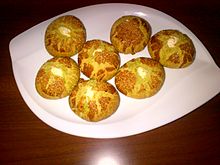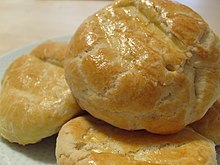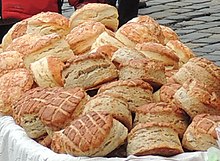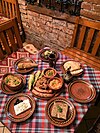| This article needs additional citations for verification. Please help improve this article by adding citations to reliable sources. Unsourced material may be challenged and removed. Find sources: "Pogača" – news · newspapers · books · scholar · JSTOR (January 2017) (Learn how and when to remove this message) |
 Poğaça stuffed with lor cheese and dill Poğaça stuffed with lor cheese and dill | |
| Alternative names | Pogacha |
|---|---|
| Type | Bread |
| Main ingredients | White flour or whole-wheat flour, usually yeast, egg, butter |
| Variations | White cheese filling, sucuk, pastirma, ground beef, potato, olive |
| Food energy (per serving) | 196kcal per 45 gr kcal |
Pogača (Cyrillic: погача; Turkish: poğaça) is a type of bread baked in the ashes of the fireplace, and later in modern ovens. Found in the cuisines of the Balkans, Levant, Turkish and Hungary it can be leavened or unleavened, though the latter is considered more challenging to make. It is generally made from wheat flour, but barley and sometimes rye may be added. It can be stuffed with potatoes, ground beef, olive, or cheese, and have grains and herbs like sesame, black nigella seed, or dried dill in the dough or sprinkled on top.
Terminology

The word derives ultimately from the Latin panis focacius, i.e. bread (panis) baked on the hearth or fireplace (focus), via the Byzantine Greek πογάτσα (pogátsa), thence entering the South Slavic languages as pogača / погача.
A variant is known as pogačice (diminutive form), a type of puff pastry eaten in Bosnia and Herzegovina, Bulgaria, Croatia, Kosovo, Montenegro, North Macedonia, Serbia, Slovenia, and Turkey (where it is called poğaça) with variations like karaköy. It is called pogatschen in Austria, and pagáče in Slovakia. It is known by similar names in other languages: pogácsa (Hungarian), pogace (Romanian), Greek: μπουγάτσα 'bughátsa', Bulgarian, Macedonian and Serbian Cyrillic: погача, Albanian: pogaçe, Arabic بغاجة (baghajah).

Slovenian pogača is a regional dish from White Carniola and Prlekija that is known locally under various names such as "belokranjska pogača", "ocvirkovca", "gerpa", "oprešak" and "postržjača". Rather than a stuffed savoury pastry, this dish is a type of traditional flatbread that is typically topped with ocvirki.
The pastry

Different localities make slightly different varieties of pogača, and thus there is a wide variety of textures and flavors. Some may be just an inch in diameter; others are much larger. Others have a crumbly scone-like consistency inside, while others are more tender like a fresh dinner roll or croissant.

In Hungary it is considered to be a cultural specialty and a Hungarikum. It evolved from small flat breads. Although the pastry was adopted from the Turks, many of its variations, such as the pork rind pogácsa (tepertős pogácsa), were born in Hungary and have been a popular dish since the Middle Ages. Popular flavours include potato, cheese, pork crackling, tejföl, túró, juhtúró, Poppy seed (mákos pogácsa), paprika (paprikás pogácsa), pumpkin seed, ramson and cabbage.
The cookbook of the Hungarian Piarist monk Kristóf Simai, written in Selmecbánya between 1795 and 1799, contains a wide variety of other pogácsas such as the honey pogácsa, butter pogácsa, spicy scones and chocolate scones.
In Hungary boszorkánypogácsa (witches' pogácsa) is also popular, a small, sweet, usually blueberry- or peach- jam or vanilla filled biscuit.
In Syrian and Turkish cuisine, poğaça can be filled with beyaz peynir (white cheese), or other fillings like black olives, potatoes, onions or ground beef.
In Culture
In Hungary it is found in most pastry shops and in subway stations. It is also an important part of Hungarian culture. Hamubasűlt Pogácsa for instance, a pogácsa made in the embers of open fires often appears in Hungarian folk tales, when the protagonist sets out on a journey carrying this one thing in his satchel. It is also the symbol of adulthood since a similar satchel (tarisznya) is given to graduates to set them on their journey in life. These are given during Graduation (Ballagás, literally: ambling) and they carry it with themselves the whole day.
See also
References
- "Poğaça". Retrieved 3 January 2016.
- "Serbian and Balkan Pogacha Bread Recipe".
- Journal of the Gypsy Lore Society. 1961. p. 41.
- "Pogaça - Traditional Bread Recipe from the Balkans". 5 October 2019.
- "English Scones Online". Wednesday, 27 October 2021
- "Hungarikumok". www.hungarikum.net. Retrieved 2024-05-25.
- "Simai, Kristóf (Márton); früher Sima". doi:10.1553/0x00284a65. Retrieved 2024-05-25.
{{cite journal}}: Cite journal requires|journal=(help) - "Flower Poğaça Rolls". King Arthur Baking.
